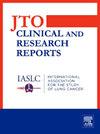2004 - 2020年早期非小细胞肺癌大叶、节段和楔形切除术的使用和生存结果的时间趋势
IF 3.5
Q2 ONCOLOGY
引用次数: 0
摘要
虽然肺叶切除术长期以来一直是早期非小细胞肺癌的标准手术治疗方法,但在过去二十年中,节段性和楔形切除术已成为另一种常用的选择。方法为了研究肺叶切除术、节段切除术和楔形切除术的使用、质量和总生存率(OS)差异的趋势,我们对2004年至2020年国家癌症数据库中76,466例T1或T2 N0M0 NSCLC肿瘤患者进行了一项观察性人群水平研究。为了比较三种治疗的OS,我们使用治疗加权逆概率来分析结检查和最小合并症负担的病例亚组。结果2004 - 2020年,肺叶切除术的比例从75.2%下降到67.6%,楔形切除术的比例保持相对稳定(20.5%-22.8%),节段切除术的比例从4.3%上升到9.7%。所有治疗的淋巴结评估和阴性边缘的可能性都增加了。年轻患者、合并症负担低的患者和肿瘤较小的患者越来越有可能接受节段性和楔形切除术。节段切除术的5年OS(80.6%, 95%可信区间[CI]: 78.1%-83.2%)仍不逊于肺叶切除术(83.6%,95% CI: 83.1%-84.1%),而楔形切除术在2016 - 2019年之前的5年OS = 79.9%, 95% CI: 75.9%-83.8%)。结论叶下切除术,尤其是节段性切除术的频率和质量都有所提高。越来越多的年轻人和更健康的患者使用叶下切除术,这表明需要更多的临床证据来证明这些趋势是否确实会带来更好的结果。本文章由计算机程序翻译,如有差异,请以英文原文为准。
Temporal Trends in the Utilization and Survival Outcomes of Lobar, Segmental, and Wedge Resection for Early-Stage NSCLC, 2004 to 2020
Introduction
Although lobectomy has long been the standard of surgical treatment for early-stage NSCLC, segmental and wedge resections have become another option often used over the past two decades.
Methods
To examine the trends over time in the utilization, quality, and overall survival (OS) differences of lobectomy, segmentectomy, and wedge resection, we performed an observational, population-level study of 76,466 patients with T1 or T2 N0M0 NSCLC tumors 2 cm or less in size in the National Cancer Database, from 2004 to 2020. To compare the OS of the three treatments, we used inverse probability of treatment weighting to analyze a subgroup of cases with nodal examination and minimal comorbidity burden.
Results
From 2004 to 2020, the use of lobectomy decreased from 75.2% to 67.6% of resections, wedge remained relatively stable (20.5%–22.8%), and segmentectomy increased from 4.3% to 9.7%. The likelihood of nodal assessments and negative margins has increased for all treatments. Younger patients, patients with low comorbidity burden, and patients with smaller tumors have become increasingly likely to receive segmental and wedge resections. Five-year OS of segmentectomy (80.6%, 95% confidence interval [CI]: 78.1%–83.2%) remained noninferior to lobectomy (83.6%, 95% CI: 83.1%–84.1%]), whereas wedge resection was inferior until 2016 to 2019 (five-y OS = 79.9%, 95% CI: 75.9%–83.8%).
Conclusions
Sublobar resections, particularly segmentectomies, have increased in frequency and quality. The growing use of sublobar resections for younger and healthier patients highlights the need for additional clinical evidence demonstrating whether these trends do indeed lead to better outcomes.
求助全文
通过发布文献求助,成功后即可免费获取论文全文。
去求助
来源期刊

JTO Clinical and Research Reports
Medicine-Oncology
CiteScore
4.20
自引率
0.00%
发文量
145
审稿时长
19 weeks
 求助内容:
求助内容: 应助结果提醒方式:
应助结果提醒方式:


